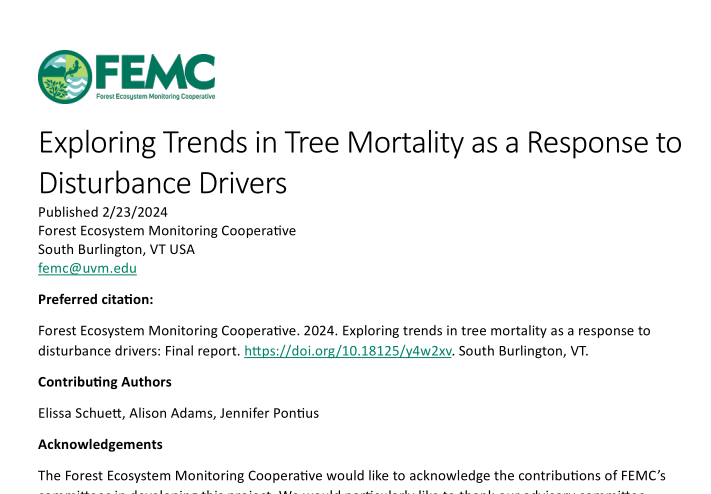
Exploring Trends in Tree Mortality as a Response to Disturbance Drivers – Regional Exploration Project
Overview:
Forest-based recreation activities are increasing with more people taking part in both motorized and non-motorized activities. Different recreation activities place varying levels and types of pressure on forests. These pressures can be concentrated (e.g., mountain bike trails) or diffuse (e.g., cutting for ski glades), with potential impacts on forest hydrology, soils, invasive species propagation, wildlife movement, tree regeneration and health. Monitoring and analysis of forest health impacts by recreational activities in the Northeast is limited, but of growing interest to land managers.
Project Objective:
The FEMC community is interested in exploring patterns of tree mortality and how regional coordination of monitoring for both acute events and delayed responses following chronic stress can lead to a better understanding of regional impacts. The information currently available from FIA data does not provide the level of detail needed by the community. Cooperators are interested in developing a rapid response plan to implement during and following outbreaks and mortality events.
Previous Activities
The purpose of this project is to develop monitoring and management practices for responding to disturbance events that result in tree mortality. The project will also explore the ability to review and compare tree mortality data currently available to evaluate how well mortality patterns compare to each other, and if there are any trends or risks that can be determined from the long-term data.
Project Products
Overview:
FEMC Working Groups provide input on the development and progress of active FEMC projects. FEMC staff organize and lead the working groups by inviting cooperators to join, defining project objectives, and developing plans to achieve the objectives.
Working Group Objective:
The Tree Mortality Working Group will consist of 6-8 individuals who have interest and expertise in monitoring or managing land following disturbance that results in mortality events. For the initial scoping phase of this project, we will focus on the impacts of Emerald Ash Borer. This specific area of focus aligns with a complementary project that is near completion, the Northeast Invasive Forest Insects Network.
FEMC staff will use the guidance provided by the working group to develop resources for monitoring and management practices of forests following acute and ongoing mortality events.
Working Group Outputs
The working group will develop a monitoring plan that can be implemented during and following a mortality event that is a result of EAB. This plan will be created to use as a template for other disturbance drivers. A regional stakeholder list will also be created to begin the process of forming a first responder network of organizations and agencies that will be available to establish monitoring and management strategies following an event.
For more information about participating on this Working Group, please review the Tree Mortality Working Group document. You are welcome to contact Elissa Schuett (Elissa.Schuett@uvm.edu) with any questions.

